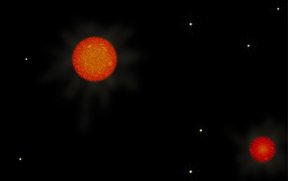Red dwarfs in the neighborhood
Astronomers have found 20 previously unknown star systems in Earth's galactic neighborhood.
By Emily Sohn
It can be hard to get to know all the people that live in your neighborhood. Keeping track of the stars in our part of the galaxy is getting harder, too. Astronomers recently found an additional 20 star systems that lie within just 33 light-years of Earth.
 |
|
A pair of red dwarfs, shown in this artist’s illustration, is among 20 newfound star systems that lie within 33 light-years of Earth.
|
| Zina Deretsky/National Science Foundation |
A light-year is the distance that light travels in 1 year—5.88 trillion miles. That may sound like a long way, but a few dozen light-years is practically next door when you consider the vast size of our galaxy, the Milky Way.
Astronomers found the stars using a telescope at the Cerro Tololo Inter-American Observatory near La Serena, Chile. The newfound stars are all red dwarfs, one of the most common types of stars in the Milky Way.
Red dwarfs are faint stars. They range in size from about a tenth to half the mass of our sun.
Because red dwarfs are so dim, they’re hard to spot directly. Instead, astronomers look for telltale spots of light that appear to wiggle back and forth slowly as Earth goes around the sun. The bigger the wiggle they observe, the closer the star is.
Fifteen of the newfound stars are out there on their own, but the astronomers noted one group of two stars and two groups of three stars among the new discoveries. This finding gives insight into how often stars occur in such small groups.
Finding new stars also gives astronomers new places to look for planets outside of our solar system.
“Red dwarf stars . . . are the closest and most numerous stars to us, so they are the best places to look for planets,” says astronomer Alan Boss of the Carnegie Institution of Washington, D.C.
Astronomers have already found planets orbiting other nearby red dwarfs. But they’ve assumed that life on such planets would be impossible.
That’s because, for a planet to have liquid water, it would have to orbit the star very closely. But such a close-in planet would find itself rotating so that one side always faces the star, making it too hot for life. The other side would always face away, making it way too cold.
However, if such a planet happened to have a thick atmosphere, for example, the heat might spread out enough to make the planet habitable. So, astronomers are now more hopeful than they were before that such planets may harbor life.
Astronomers expect to find even more nearby star systems. So, the possibilities for life elsewhere in the universe are bound to multiply.







